The Rockets finished with a .500 or better record for 14 consecutive seasons from 2007-20. When their franchise player, former MVP James Harden, asked for — and was granted — a trade to start 2020/21, it was the beginning of a rough three-year stretch of basketball in Houston.
The team finished with the worst record in the league in both ’20/21 and ’21/22, and was tied with San Antonio at 22-60 for the NBA’s second-worst mark in ’22/23. The Rockets finished 30th, 30th and 29th in defensive rating over those three seasons, so obviously improving on that front will be a top priority under new head coach Ime Udoka, who replaced Stephen Silas after the Rockets declined to pick up their option on the last year of Silas’ contract.
The past two draft lotteries have seen the Rockets land the second (Jalen Green) and third (Jabari Smith) overall picks. Will 2023 be the year they win the lottery and select Victor Wembanyama?
They’re certainly hoping that’s the case. After winning a tiebreaker with the Spurs, Houston will draft no lower than sixth overall.
The Rockets’ Offseason Plan:
There have been conflicting reports over the past week about the status of at least one member of the team’s core. One rumor stated that, while interviewing head coaches, the Rockets broached the subject of including Green in trade talks to try and acquire a star this summer. Another indicated that Green, Smith, Tari Eason and Alperen Sengun were Houston’s primary core.
 I don’t think the idea of trading Green should be entirely dismissed, but I’d be surprised if he’s moved. He’s still only 21 years old and has two years left on his rookie contract. Sure, he’s struggled with scoring efficiency and defense, but those are normal growing pains for a young player, and it’s not like the Rockets had a strong foundation on either end of the court.
I don’t think the idea of trading Green should be entirely dismissed, but I’d be surprised if he’s moved. He’s still only 21 years old and has two years left on his rookie contract. Sure, he’s struggled with scoring efficiency and defense, but those are normal growing pains for a young player, and it’s not like the Rockets had a strong foundation on either end of the court.
The other three players mentioned should be safe. One big knock I had against Silas was how disorganized the Rockets were offensively. The fact that he admitted the team rarely ran plays for Smith – who struggled to find quality looks throughout his rookie season – was unacceptable to me, because they were setting him up to fail — it’s not like he was known as a shot creator coming out of Auburn.
Kevin Porter Jr. and/or Jae’Sean Tate look to me like the most likely trade candidates on the roster. That’s not to suggest I necessarily think they will be traded or that they’re bad players — just that they make the most sense to be on the block from a fit standpoint. I don’t think Porter is a true point guard, and while Tate brings a lot of positive attributes, he’s not a good three-point shooter.
After a solid third season, Kenyon Martin Jr. is a good bet to return, either on his minimum-salary team option or – if the Rockets turn down his option to negotiate with him as a restricted free agent, like they did last summer with Tate – on a new contract. I don’t think Daishen Nix will be on the roster in ‘23/24 – his salary is non-guaranteed, and while he’s only 21, he was among the worst semi-regular rotation players in the NBA this season.
Armed with the most cap room in the NBA this summer (about $60MM), the Rockets will certainly look to be aggressive and make major strides in ‘23/24, for a number of different reasons. For starters, if the team is unable to land any of its top targets, I could see general manager Rafael Stone getting fired before the season even begins, because the front office has been very forthright about building toward this point in time.
A report in December indicated that owner Tilman Fertitta has grown “antsy” with the state of the Rockets’ rebuild. That makes sense – it’s a drastically different team than the one he purchased, and it has lost a lot of games lately.
Another reason Houston wants to improve next season is the team owes its 2024 first-round pick (top-four protected) to Oklahoma City as part of the Chris Paul/Russell Westbrook trade (the Rockets owe the Thunder their 2026 first-rounder as well).
When you’re as bad as the Rockets have been over the past three seasons, you need help everywhere. Aside from the defense, three other areas in particular stand out: three-point accuracy, assists and turnovers. They finished last in the league in all three of those categories.
Perhaps that’s why the Rockets have been consistently linked to Harden this season. One of the most prolific scorers and three-point shooters in NBA history, the 33-year-old led the league in assists for the second time in ’22/23 at 10.7 APG. He also posted a career-best 3.17-to-1 assist-to-turnover ratio.
Harden holds a $35.64MM player option for ‘23/24 and is far from a lock to leave Philadelphia, where he has a much better shot at winning his first championship. Still, there’s a reason the rumors won’t go away, and his ties to Houston are obvious.
The problem is, if the Rockets give him a four-year max deal projected to start at $46.9MM (and a total of $201.67MM), they won’t have enough remaining cap room to sign another veteran impact player — maybe someone like Jerami Grant. Perhaps Harden would be willing to take another discount like he did last summer to improve the team, but that’s a tougher sell with a team that isn’t close to contention.
That’s one reason why I wouldn’t be surprised if Porter is dealt, because it could open up enough salary to sign another player at a starting salary of about $31MM.
Harden might not even be atop Houston’s wish list. He’s a decade older than most of the players on the roster, as is Khris Middleton, another player who has been floated as a potential target.
They’ll have other options. Not a ton, because it’s not a great free agent class, but there are alternatives.
Splitting that $60MM to go after Fred VanVleet and Grant could be one route they could take. Or VanVleet and a big offer sheet to Cameron Johnson. Or using some of their cap room on a free agent and the rest to accommodate a trade for a disgruntled star. You get the point.
The Rockets’ draft assets shouldn’t be overlooked either. While the club probably won’t trade its lottery pick, its second first-rounder (No. 20) could be a useful sweetener if the team wants to make a win-now trade.
The most important thing will be to not strike out, because the advantage of remaining below the cap floor has been reduced in the new CBA, and the Rockets have plenty of incentives to improve.
Salary Cap Situation
Guaranteed Salary
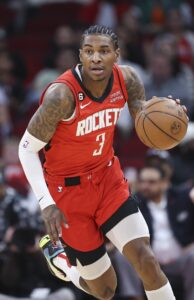 Kevin Porter Jr. ($18,239,000)
Kevin Porter Jr. ($18,239,000)- Jalen Green ($9,891,480)
- Jabari Smith ($9,326,520)
- Jae’Sean Tate ($6,500,000)
- Alperen Sengun ($3,536,280)
- Tari Eason ($3,527,160)
- Usman Garuba ($2,588,400)
- Josh Christopher ($2,485,200)
- TyTy Washington ($2,320,440)
- Total: $58,414,480
Dead/Retained Salary
- None
Player Options
- None
Team Options
- Kenyon Martin Jr. ($1,930,681): Bird rights
- Note: If Martin’s option is exercised, his salary would become guaranteed two days before the July moratorium. If it’s not exercised, he would be eligible for restricted free agency.
- Total: $1,930,681
Non-Guaranteed Salary
- Daishen Nix ($1,836,096)
- Total: $1,836,096
Restricted Free Agents
- None
Two-Way Free Agents
Draft Picks
- No. 2 overall ($10,718,760)
- Note: This is only a placeholder until the draft order is determined via the lottery.
- No. 20 overall ($3,170,400)
- Total: $13,889,160
Extension-Eligible Players
- Kenyon Martin Jr. (veteran)
Note: These are players who are either already eligible for an extension or will become eligible before the 2023/24 season begins.
Unrestricted Free Agents / Other Cap Holds
- Frank Kaminsky ($1,989,698 cap hold): Non-Bird rights
- Boban Marjanovic ($1,989,698 cap hold): Bird rights
- D.J. Augustin ($1,989,698 cap hold): Non-Bird rights
- Willie Cauley-Stein ($1,989,698 cap hold): Non-Bird rights
- Michael Frazier ($1,774,999 cap hold): Early Bird rights
- Total: $9,733,791
Note: Frazier’s cap hold remains on the Rockets’ books from a prior season because it hasn’t been renounced. He can’t be used in a sign-and-trade deal.
Cap Exceptions Available
- Room exception: $7,609,000
- Trade exception: $3,892,917
- Note: Expires on June 26.
- Trade exception: $3,089,360
- Trade exception: $293,920
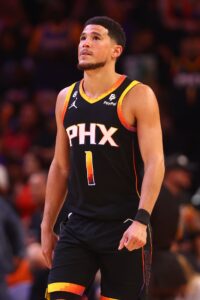 The figures above explain why
The figures above explain why 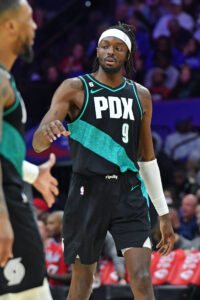 The trade package the Blazers gave up for Grant
The trade package the Blazers gave up for Grant 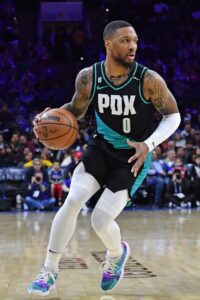
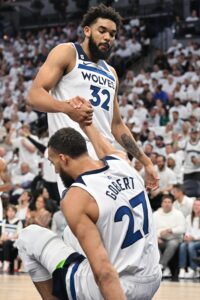 With huge contracts committed to Gobert and
With huge contracts committed to Gobert and 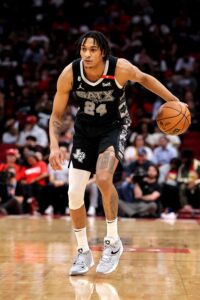 Considering they finished 29th in offense and 30th in defense with the worst net rating in the league (a brutal minus-9.9), it’s safe to say the Spurs need help wherever they can find it. A star to build around would be a great place to start, but they’ll almost certainly have to hope that will come via the draft or through internal development.
Considering they finished 29th in offense and 30th in defense with the worst net rating in the league (a brutal minus-9.9), it’s safe to say the Spurs need help wherever they can find it. A star to build around would be a great place to start, but they’ll almost certainly have to hope that will come via the draft or through internal development.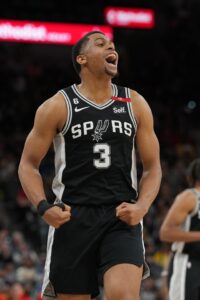
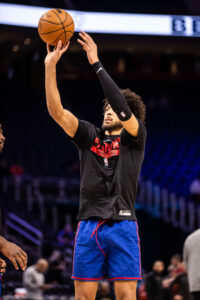 Injuries certainly played a role in that – 2021 No. 1 overall pick
Injuries certainly played a role in that – 2021 No. 1 overall pick 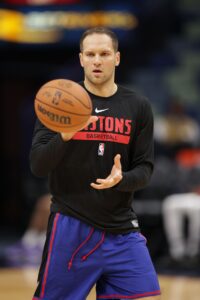
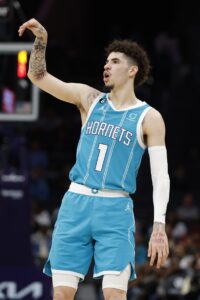
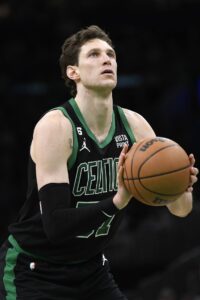
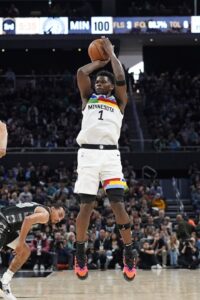 After spending much of his first two seasons playing small forward, Edwards primarily played shooting guard in 2022/23 and had a career year, averaging 24.6 points, 5.8 rebounds, 4.4 assists and 1.6 steals on .459/.369/.756 shooting in 79 regular season games (36.0 MPG). The top overall pick of 2020 was named an All-Star for the first time this season.
After spending much of his first two seasons playing small forward, Edwards primarily played shooting guard in 2022/23 and had a career year, averaging 24.6 points, 5.8 rebounds, 4.4 assists and 1.6 steals on .459/.369/.756 shooting in 79 regular season games (36.0 MPG). The top overall pick of 2020 was named an All-Star for the first time this season.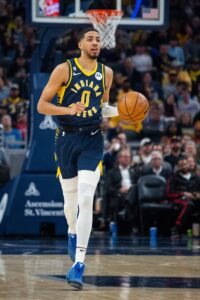 Several draft analysts had Haliburton high on their boards, but he wound up falling to the Kings at No. 12 overall. He played very well in his stint with Sacramento, but his fit with fellow point guard
Several draft analysts had Haliburton high on their boards, but he wound up falling to the Kings at No. 12 overall. He played very well in his stint with Sacramento, but his fit with fellow point guard 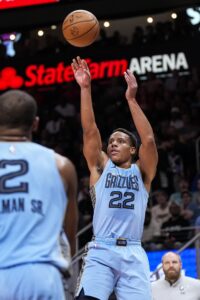 A four-year college player out of TCU, Bane was the last pick of the first round in 2020. He had a quality rookie season, mostly off the bench, averaging 9.2 points and 3.1 rebounds on .469/.432/.816 shooting in 68 games (17 starts, 22.3 MPG).
A four-year college player out of TCU, Bane was the last pick of the first round in 2020. He had a quality rookie season, mostly off the bench, averaging 9.2 points and 3.1 rebounds on .469/.432/.816 shooting in 68 games (17 starts, 22.3 MPG).